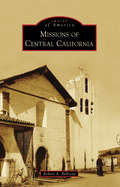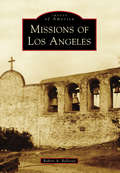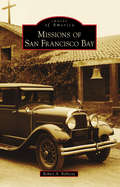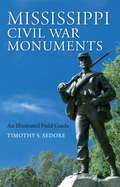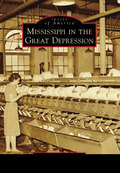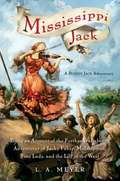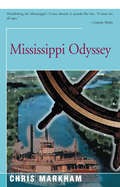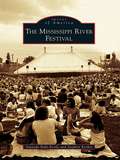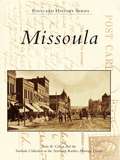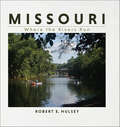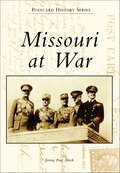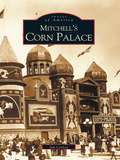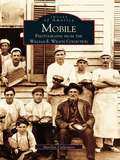- Table View
- List View
Missionary of Tanganyika 1877-1888
by Edward Coode HoreThis account of an evangelical initiative at Lake Tanganyika was first published in 1892. It looks at Ujiji society and commerce and includes a description and comparison of the peoples that was done for the Anthropological Institute.
Missions of Central California
by Robert A. BellezzaAfter the discovery of Alta California, the Spanish Crown charged the first Franciscan friars to enter into the New World through Lower Baja, with a succession of conquistadors, explorers, and soldiers, on a trail called El Camino Real or "The Royal Road." The settlement began in 1769 at Mission San Diego de Alcalá, a new port and military presidio with buildings of mud, brushwood, and tule grass. Fr. Junípero Serra, the legendary mission presidente and founding father of nine missions, traveled along a worn path lined today by symbolic bell markers leading to many remarkable, modern cities. After 1772, settlements were spread to California's central coast region, filling with native neophytes who became the residents and builders of all mission settlements. The Spanish missions had brought dramatic changes to California's landscape and forged the underpinnings of its earliest history, founded serendipitously with the American Revolution and birth of the United States.
Missions of Los Angeles
by Robert A. BellezzaAfter establishing the settlement of San Francisco, visionary mission president Fr. Junipero Serra journeyed south to found Mission San Juan Capistrano, Alta California's seventh, on November 1, 1776. By order of King Carlos III of Spain, El Pueblo de la Reina de los Ángeles (the Town of Our Lady the Queen of the Angels) was founded on September 4, 1781, following the recommendation of the first California governor, Felipe de Neve. At nearby Mission San Gabriel Arcángel, de Neve gathered a group of 11 men, 11 women, and 22 children, soldiers, mission priests, and a few Indians and traveled nine miles to the banks of the Los Angeles River, blessing the new site. By 1800, the city of Los Angeles had a population of 300 with a meeting hall, guardhouse, army barracks, and granary. Built a day's journey apart on El Camino Real, the Mission San Fernando Rey de España was dedicated on September 8, 1797, and completed the lineage of California's monumental landmark missions near Los Angeles.
Missions of San Diego
by Robert A. BellezzaCalifornia's first settlement began on a trail called El Camino Real, or "The Royal Road," that was traveled by missionary pathfinders, soldiers, and conquistadors on a dramatic journey into a mysterious land. Monterey was discovered in 1603, leading to the quest. Explorers Don Gaspar de Portolá and Juan Bautista de Anza, along with ambitious Franciscan missionaries, founded 21 monumental Spanish missions and several asistencias and chapels for native neophytes, travelers, and visitors to Alta California. Following the initial landing in 1769 at San Diego's seaport, Fr. Junípero Serra founded Mission San Diego de Alcalá, California's first landmark, at the original presidio site. The mission stands today exactly where it was moved, rebuilt, and completed in 1813. The native populations of California witnessed years of change from a sleepy province to the status of US statehood. The Spanish missions forged the powerful underpinnings of the Golden State's earliest settlements 80 years prior to the world's largest migration to California, the 1849 Gold Rush.
Missions of San Francisco Bay
by Robert A. BellezzaLegendary explorer Lt. Col. Juan Bautista de Anza completed a 1,000-mile journey from Sonora, Mexico, crossing the Mojave Desert with the first settlers, to San Francisco's pristine harbor. Fr. Francisco Palóu celebrated the dedication of Mission San Francisco de Asís on June 29, 1776. First established to protect Spain's interests in Alta California from foreign ships, California's landmark buildings are featured here with newly discovered photography depicting a romantic era of colorful Spanish conquistadors, Franciscan padres, and mission Indian neophytes from 1769 to 1823. Explore the heritage of California pioneers' first communities and the 21 California Spanish missions of adobe, stone, and tile that are considered architectural wonders that have captured the imagination of visitors and historians over centuries.
Mississippi! (Wagons West Series, Book #15)
by Dana Fuller RossFrom north of St. Louis down past Natc Kez to the fertile Bayou, the broad deep river carried barges piled high with valuable cargo and stern -wheelers crowded with eager Americans hungry for the sin and sweetness of exciting New Orleans, But on its seamier streets a dark underworld flourished. There, a cruel ex-lawman hid the beautiful young gentlewoman he had seduced with lies, while he plotted to kill the bold Englishman who had sworn to avenge her honor. And from the far west rode Toby Holt-a fighting man as famous as his father, Wagonmaster Whip Holt-to wage a one- man war on a dreaded Oriental Tong... as the forces of good and evil prepared to battle for control of this rich, fast growing land along the MISSISSIPPI!
Mississippi Civil War Monuments: An Illustrated Field Guide
by Timothy S. Sedore“From Vicksburg to Oxford, readers will find a rich examination of how and why Confederate and Union monuments sprang up across the state.” —Caroline E. Janney, Director, John L. Nau III Center for Civil War History, University of VirginiaSoaring obelisks, graceful arches, and soldiers standing tall atop pedestals recall the memory of the Civil War in Mississippi, a former Confederate state that boasts more Civil War monuments than any other.In Mississippi Civil War Monuments: An Illustrated Field Guide, Timothy S. Sedore combs through the Mississippi landscape, exploring monuments commemorating important military figures and battles and remembering common soldiers, from rugged veterans to mournful youths. Sedore’s insightful commentary captures a character portrait of Mississippi, a state that was ensnared between Northern and Southern ideologies and that paid a high price for seceding from the Union. Sedore’s close examinations of these monuments broadens the narrative of Mississippi’s heritage and helps illuminate the impacts of the Civil War.With intriguing details and vivid descriptions, Mississippi Civil War Monuments offers a comprehensive guide to the monuments that make up Mississippi’s physical and historical landscape.
Mississippi Civil War Monuments: An Illustrated Field Guide
by Timothy S. Sedore“From Vicksburg to Oxford, readers will find a rich examination of how and why Confederate and Union monuments sprang up across the state.” —Caroline E. Janney, Director, John L. Nau III Center for Civil War History, University of VirginiaSoaring obelisks, graceful arches, and soldiers standing tall atop pedestals recall the memory of the Civil War in Mississippi, a former Confederate state that boasts more Civil War monuments than any other.In Mississippi Civil War Monuments: An Illustrated Field Guide, Timothy S. Sedore combs through the Mississippi landscape, exploring monuments commemorating important military figures and battles and remembering common soldiers, from rugged veterans to mournful youths. Sedore’s insightful commentary captures a character portrait of Mississippi, a state that was ensnared between Northern and Southern ideologies and that paid a high price for seceding from the Union. Sedore’s close examinations of these monuments broadens the narrative of Mississippi’s heritage and helps illuminate the impacts of the Civil War.With intriguing details and vivid descriptions, Mississippi Civil War Monuments offers a comprehensive guide to the monuments that make up Mississippi’s physical and historical landscape.
Mississippi in the Great Depression (Images of America)
by Richelle PutnamBy the time the Great Depression was well underway, Mississippi was still dealing with the lingering effects of the flood of 1927 and the Mississippi Valley drought of 1930. As Pres. Franklin Roosevelt took office in 1933, Mississippi senator Pat Harrison, chair of the Senate Committee on Finance, oversaw the passage of major New Deal legislation, from which Mississippi reaped many benefits. Other Mississippi politicians like Gov. Mike Connor initiated measures to improve the treatment of inmates at Parchman Prison in the Delta and Gov. Hugh White established the Balancing Agriculture with Industry initiative. Women also played an active role. The Natchez Garden Club successfully spurred tourism by starting the state's first pilgrimage in 1932. Mississippians found employment through the Public Works Administration and the Civilian Conservation Corps, which stimulated economic development through new and add-on construction in urban and rural areas and the construction of nine state parks. For black Mississippians, segregation and discrimination in New Deal benefits and jobs continued, but what they did receive from the federal government spurred a determination to fight for equality in the Jim Crow South.
Mississippi Jack: Being an Account of the Further Waterborne Adventures of Jacky Faber, Midshipman, Fine Lady, and the Lily of the West (Bloody Jack #5)
by L. A. MeyerThe intrepid Jacky Faber, having once again eluded British authorities, heads west, hoping that no one will recognize her in the wilds of America. There she tricks the tall-tale hero Mike Fink out of his flatboat, equips it as a floating casino-showboat, and heads south to New Orleans, battling murderous bandits, British soldiers, and other scoundrels along the way. Will Jacky's carelessness and impulsive actions ultimately cause her beloved Jaimy to be left in her wake? Bold, daring, and downright fun, Jacky Faber proves once again that with resilience and can-do spirit, she can wiggle out of any scrape . . . well, almost.
Mississippi Odyssey
by Chris MarkhamSince his teens, Chris Markham's hitchhiking thumb has carried him into adventures across America. His first book, Mississippi Odyssey, is a journal of his experiences hitchhiking boat rides down the Mississippi River.
Mississippi River Festival, The
by Stephen Kerber Amanda Bahr-EvolaIn 1969, Southern Illinois University Edwardsville initiated a remarkable performing arts series called the Mississippi River Festival. Over 12 summer seasons, between 1969 and 1980, the festival presented 353 events showcasing performers in a variety of musical genres, including classical, chamber, vocal, ragtime, blues, folk, bluegrass, barbershop, country, and rock, as well as dance and theater. During those years, more than one million visitors flocked to the spacious Gyo Obata-designed campus in the countryside near St. Louis. The Mississippi River Festival began as a partnership promoting regional cooperation in the realm of the performing arts. Southern Illinois University Edwardsville invited the St. Louis Symphony to establish residence on campus and to offer a summer season. To host the symphony, the university created an outdoor concert venue within a natural amphitheater by installing a large circus tent, a stage and acoustic shell, and a sophisticated sound system. To appeal to the widest possible audience, the university included contemporary popular musicians in the series. The audacity of the undertaking, the charm of the venue, the popularity of the artists, the excellence of the performances, and the nostalgic memory of warm summer evenings have combined to endow the festival with legendary status among those who attended.
Mississippi Solo: John Murray Journeys (Overcoming Books)
by Eddy L HarrisINTRODUCED BY ADAM WEYMOUTH, award-winning author of The Kings of Yukon'A wonderful book -- and a highly original contribution to the literature of travel' PAUL THEROUX'The Mississippi. Mighty, muddy, dangerous, rebellious and yet a strong, fathering kind of river. The river captured my imagination when I was young and has never let go.' Mississippi Solo tells the story of one man's voyage by canoe down the Mississippi River from its source in Minnesota to the Gulf of Mexico - a longtime dream, and a journey of over 2,000 miles through the heart of America. Paddling into the Southern states - going from 'where there ain't no black folks to where they still don't like us much' - Eddy is confronted by the legacy of slavery and modern racism, including an incident with a pair of shotgun-toting bigots. There are also the dangers of passing barges, wild dogs roaming the wooded shore, and navigating a waterway that grows vaster, and more hazardous, every day. But Eddy also encounters immense human kindness, friendship and hospitality, as well as coming to know the majestic power - and the awesome dangers - of the river itself. Mississippi Solo is an unforgettable American adventure.
Mississippi Solo: A River Quest
by Eddy L. Harris Eddy HarrisSince the publication of his first book, Mississippi Solo, Eddy L. Harris has been praised for his travel writing. In this exciting reissue of his classic travelogue, readers will come to treasure the rich insightful prose that is as textured as the Mississippi River itself. They will be taken by the hand by an adventurer whose lifelong dream is to canoe the length of this mighty river, from Minnesota to New Orleans. The trip's dangers were legion for a Black man traveling alone, paddling from "where there ain't no black folks to where they still don't like us much." Barge waives loom large, wild dogs roam the wooded shores, and, in the Arkansas dusk, two shotgun-toting bigots nearly bring the author's dream to a bloody . Sustaining him through the hard weeks of paddling were the hundreds of people who reached out to share a small piece of his challenge. Mississippi Solo is a big, rollicking, brilliant book, a wonderful piece of American adventure, and an unforgettable story of a man testing his own limits.
Missoula
by Svoboda Collection at the Northern Rockies Heritage Center Stan B. CohenMissoula began in 1860 as Hellgate Village, a trading post located about 4 miles west of what is now downtown. In 1864, the construction of a mill powered by water diverted from Rattlesnake Creek drew residents of Hellgate to the new town, and the arrival of the Northern Pacific Railroad in 1883 assured Missoula's future. The establishment of the University of Montana led to growth on the south side of the Clark Fork River, and the timber industry drove the economy. Missoula has evolved into a trade, medical, educational, and governmental center of western Montana.
Missouri: Where the Rivers Run
by Robert E. HulseyKnown for its scenic rivers, reowned state parks and beautiful vistas, Missouri offers enjoyment for anyone seeking a variety landscapes, natural wonders, charming small towns, and cosmopolitan urban Known for its scenic rivers, renowned state parks and beautiful vistas, Missouri offers enjoyment for anyone seeking a variety of landscapes, natural wonders, charming small towns, and cosmopolitan urban adventures. In Missouri: Where the Rivers Run, follow photographer Robert E. Hulsey on a visual journey across the Show-Me State as he travels from the rolling plains in the northern part of the state to the Ozark Mountains in the south, showcasing the natural heritage along the way. Through these 175 stunning photographs, visit the lush hiking trails at Graham Cave State Park, experience a float trip down the Black River, witness a celebration in Mark Twain's hometown, and get the perfect view of the Cathedral Basilica's painted ceiling. Through the lens of his camera, Robert captures the many wonders of the state and the people who call it home.A beautiful coffee-table book, Missouri: Where the Rivers Run will inspire travelers to explore the splendor and the history of this picturesque Midwest state.
Missouri at War (Postcard History Series)
by Jeremy Paul AmickThe Show-Me State possesses an enduring military heritage that unfolded several decades before it became a state in 1821 and stretches forth to the present day. Missouri has molded many notable military leaders, such as Gen. John J. Pershing, the commander of the American Expeditionary Forces in World War I. It has been the site of a Spanish fort, built in the area that is now downtown St. Louis, and serves as the home of the Liberty Memorial in Kansas City. These people and memorials continue to generate reminders to its citizens of the sacrifices made by the brave men and women who have fought on behalf of the state and nation.
Missouri in World War I (Images of America)
by Jeremy Paul AmickThe state of Missouri played a unique role in World War I--as the birthplace of Gen. John J. Pershing, the commanding officer of the American Expeditionary Forces, and Maj. Gen. Enoch Crowder, the primary author of the military draft--and it is an impressive legacy featuring a colorful cast of characters, events, and communities. Missouri was home to two flying aces of the war as well as Bennett Champ Clark, the youngest colonel in the American Expeditionary Forces and the first national commander of the American Legion. During the war, the state was home to farms and ranches that provided an army of mules that assisted Allied forces in hauling critical materials and equipment in the harshest of conditions. Additionally, 156,000 of the state's citizens served in the military with approximately 10,000 wounded or killed in action.
A Mistletoe Miracle: The perfect feel-good holiday romcom to read this year
by Emma JacksonDon't miss Emma Jackson's new festive romance: One Kiss Before Christmas!At the Everdene Hotel, snowflakes, romance and mayhem are in the air... A cosy hotel in a sleepy, snow-covered village should be the perfect setting for a Christmas to remember... But for Beth, returning to her childhood home after a disastrous break-up looks more like a festive fiasco. With her mum stranded in a blizzard and most of the hotel staff off sick, Beth is forced to take the reins, impress a mystery hotel reviewer, and somehow find a way to work with Nick, the very grumpy - and very gorgeous - pilot who is staying for the holidays. Between mince pie emergencies, deadly decorations, and two dozen disgruntled guests, Beth might just find a miracle under the mistletoe this Christmas...Heartwarming and hilarious, this is the perfect festive romance to curl up with this winter. Perfect for fans of Heidi Swain and Sue Moorcroft.
A Mistletoe Miracle: The perfect feel-good holiday romcom to read this year
by Emma JacksonDon't miss Emma Jackson's new festive romance: One Kiss Before Christmas!At the Everdene Hotel, snowflakes, romance and mayhem are in the air... A cosy hotel in a sleepy, snow-covered village should be the perfect setting for a Christmas to remember... But for Beth, returning to her childhood home after a disastrous break-up looks more like a festive fiasco. With her mum stranded in a blizzard and most of the hotel staff off sick, Beth is forced to take the reins, impress a mystery hotel reviewer, and somehow find a way to work with Nick, the very grumpy - and very gorgeous - pilot who is staying for the holidays. Between mince pie emergencies, deadly decorations, and two dozen disgruntled guests, Beth might just find a miracle under the mistletoe this Christmas...Heartwarming and hilarious, this is the perfect festive romance to curl up with this winter. Perfect for fans of Heidi Swain and Sue Moorcroft.
MIT: An Architectural Tour
by Mark Jarzombek Douglass Shand-Tucci L. Rafael Reif John HornerThe Massachusetts Institute of Technology (MIT) was founded in 1861 as the cornerstone of Copley Square in Boston's Back Bay, then the center of a progressive, proto-globalist Brahmin culture committed to intellectual modernism and educational innovation. MIT founder William Barton Rogers's radical vision to teach by "mind and hand" was immediately successful.In 1916 MIT, growing by leaps and bounds, moved its campus to the nearby Charles River Basin in Cambridge, where it now stretches along the shore overlooking the Back Bay. MIT: The Campus Guide presents the history of the Institute's founding and its two campuses. Today, the campus is studded with buildings designed by noted architects such as William Welles Bosworth, Alvar Aalto, Eero Saarinen, I. M. Pei, Steven Holl, Charles Correa, J. Meejin Yoon, Frank Gehry, and Fumihiko Maki, among others. Alongside the architecture is a distinguished array of public art including works by Picasso, Henry Moore, Alexander Calder, Louise Nevelson, Frank Stella, Sol LeWitt, and Jaume Plensa.
Mitchell's Corn Palace
by Jan CerneyThe world's only Corn Palace began as "The Corn Belt Exposition" in 1892, a promotional enterprise established to showcase the rich agricultural region of the James Valley. The exposition became a popular annual event, and an icon of the American prairie. The Corn Palace has occupied three different buildings since 1892. Adorned each autumn with corn, grains, and native grasses in decorative patterns and themes, the Corn Palace has hosted famous entertainers, politicians, and community events. Now well into its second century and going strong, the Corn Palace has become a symbol of South Dakota. Mitchell's Corn Palace tells the unique story of the palace through a collection of over 200 fascinating vintage images, chronicling this unique piece of Americana.
Mobile: Photographs from the William E. Wilson Collection (Images of America)
by Marilyn CulpepperBeautiful Mobile, Alabama, on the Gulf of Mexico, has a colorful history dating back to its founding in 1702. Few photographers have captured the essence of Mobile-its people, places, and events-to the extent of master photographer William Ernest Wilson. Wilson's photography vividly depicts Mobile life at the turn of the twentieth century and is the subject of this engaging visual journey. From nationally elected officials such as Theodore Roosevelt to local Mardi Gras royalty, from entrepreneur Gordon Smith of Smith's Bakery to Africa Town founder Cudjoe Lewis, from a stately cathedral to country churches, from thriving banks and theaters to lumber yards and banana docks, the people and places of Mobile are revealed through Wilson's camera as a kaleidoscope of life in a bustling seaport. Artistic shading and Wilson's innate ability to see beyond the lens give his photographs an air of the contemporary while reflecting a bygone era of simplicity. These images simultaneously reveal the height of Victorian photographic art and daily life in one of the South's first major cities. Covering the period from 1894 to 1905, the collection features personalities, street scenes, and architectural treasures of the past. Preserved on their original dry glass negatives, a significant portion of Wilson's Mobile photographs are collected and printed here in a single edition for the first time.
Mobile Home: A Memoir in Essays (Association of Writers and Writing Programs Award For Creative Nonfiction Ser.)
by Megan HarlanUprooting ourselves and putting down roots elsewhere has become second nature. Americans are among the most mobile people on the planet, moving house an average of nine times in adulthood. This book explores one family's extreme and often international version of this common experience. Inspired by the author's globe-wandering childhood-during which she lived in seventeen homes across four continents, ranging in location from the Alaskan tundra to a Colombian jungle, a posh flat in London to a doublewide trailer near the Arabian Gulf-the book maps the emotional structures and metaphysical geographies of home. In ten interconnected essays, the author examines cultural histories that include Bedouin nomadic traditions and modern life in wheeled mobile homes, the psychology of motels and suburban tract housing, and the lived meanings within the built landscapes of Manhattan, Stonehenge, and the Winchester Mystery House. More personally, she traces the family histories that drove her parents to seek so many new horizons-and how those places shaped her upbringing. Her mother viewed houses as a kind of large-scale plastic art ever in need of renovating, while her father was a natural adventurer and loved nothing more than to travel, choosing a life of flight that also helped to mask his addiction to alcohol. These familial experiences color the author's current journey as a mother attempting to shape a flourishing, rooted world for her son. Her memoir in essays skillfully explores the flexible, continually inventive natures of place, family, and home.
Mobile Narratives: Travel, Migration, and Transculturation (Routledge Interdisciplinary Perspectives on Literature #18)
by Eleftheria Arapoglou Mónika Fodor Jopi NymanEmphasizing the role of travel and migration in the performance and transformation of identity, this volume addresses representations of travel, mobility, and migration in 19th–21st-century travel writing, literature, and media texts. In so doing, the book analyses the role of the various cultural, ethnic, gender, and national encounters pertinent to narratives of travel and migration in transforming and problematizing the identities of both the travelers and "travelees" enacting in the borderzones between cultures. While the individual essays by scholars from a wide range of countries deal with a variety of case studies from various historical, spatial, and cultural locations, they share a strong central interest in the ways in which the narratives of travel contribute to the imagining of ethnic encounters and how they have acted as sites of transformation and transculturation from the early nineteenth century to the present day. In addition to discussing textual representations of travel and migration, the volume also addresses the ways in which cultural texts themselves travel and are reconstructed in various cultural settings. The analyses are particularly attentive to the issues of globalization and migration, which provide a general frame for interpretation. What distinguishes the volume from existing books is its concern with travel and migration as ways of forging transcultural identities that are able to subvert existing categorizations and binary models of identity formation. In so doing, it pays particular attention to the performance of identity in various spaces of cultural encounter, ranging from North America to the East of Europe, putting particular emphasis on the representation of intercultural and ethnic encounters.

